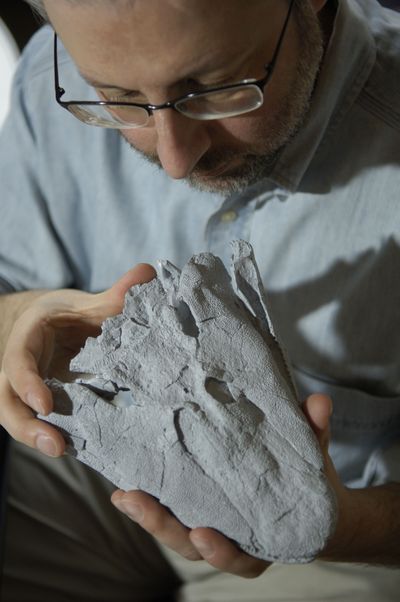Fossil gives us a leg up on evolution
Scientists learn more about transitional species

The enigmatic 375 million-year-old fossils of a fish in the midst of adapting to life on land are giving up more of their secrets.
Scientists first described the stubby aquatic predator they named Tiktaalik in 2006, focusing on the anatomical features that showed its front fins were on their way to becoming limbs, and were capable of lifting the animal in a kind of push-up out of the ancient muck.
Now, the team that discovered Tiktaalik in the Canadian Arctic provided new details of its transition from water to solid ground. Further examination of the fossils shows a coordinated series of changes under way not just in the creature’s limbs, but in its crocodile-like skull, neck and gills, all helping prepare it for a less aquatic, shallow-water lifestyle.
The findings are reported in the October issue of Nature by Jason Downs, Ted Daeschler, Farish A. Jenkins Jr. and Neil Shubin. The researchers discussed them publicly during a symposium at Thursday’s meeting of the Society of Vertebrate Paleontology meeting in Cleveland.
“We designed an expedition to find a transitional fossil and, bingo, we found it. And it was loaded with surprises,” said Shubin, of the University of Chicago. “We’re learning so much about the history of life.”
The scientists initially dug three Tiktaalik partial skeletons from shale outcrops on Canada’s Ellesmere Island, more than 600 miles above the Arctic Circle. (Tiktaalik, pronounced tick-TAH-lick, is an Inuit word meaning large fresh-water fish.)
The landscape is harsh, cold and barren, with winds that can shred tents. Researchers carry guns in addition to their digging tools to protect against roaming polar bears.
In Tiktaalik’s time, though, the area was part of a giant landmass that lay much closer to the equator and was a sub-tropical floodplain. The fossilized remains show Tiktaalik ranged from 4 to 9 feet long, with sharp teeth for flesh-eating and eyes on the top of its flat head.
The fossil site where Tiktaalik roseae was discovered is high in the Canadian Arctic on Ellesmere Island.
It had some features of its lobe-finned ancestors, such as scales, webbed fins and primitive jaws. But it also bore similarities to later, four-legged, land-dwelling animals called tetrapods. It had both lungs and gills.
Tiktaalik’s shoulders and upper arm bones were in the process of rotating from a rearward, swimming orientation to a forward-facing direction, and its elbows and wrists could bend to enable a propped-up posture and perhaps some limited, dragging locomotion.
By painstakingly removing the surrounding rock in which the Tiktaalik specimens were embedded, the researchers were able to study more features of an animal caught in transition, particularly in the skull and gill area. Guided by genes, its skeleton was reorganizing itself.
Tiktaalik lacked the rigid gill-covering bones of its ancestors. That made its head more flexible; it’s the first time a neck appears in the fossil record. Because they can quickly flick their bodies in any direction in the water, fish have no pressing need for independent head motion.
But an animal like Tiktaalik that’s rooted to the ground by its developing limbs would need more head mobility to snare prey or catch a glimpse of an attacker.
The Tiktaalik fossils showed evidence of more changes tied to an aquatic exit strategy. The skulls of fishes have lots of connected, hinge-like moving bones that help the head skeleton function like a pump to move water across the gills during breathing.
In Tiktaalik, one of those head bones, called the hyomandibula, was shrinking in size compared to the creature’s fish ancestors. In those primitive creatures, the boomerang-shaped hyomandibula links parts of the skull and the gill bones, coordinating how those elements move during underwater breathing and eating.
Tiktaalik’s hyomandibula is smaller and in a different position, perhaps because the animal was living in shallow water and relying less on its gills to breathe. In mammals, which don’t need gills at all, the hyomandibula is freed up for another role: it’s become a tiny middle-ear bone involved in hearing.
“It’s just one piece of the puzzle,” said paleontologist Jason Downs, the Nature paper’s lead author and a research fellow at Philadelphia’s Academy of Natural Sciences. “One reason why people are intrigued by Tiktaalik is that it isn’t some oddball animal that went extinct. It’s on the lineage leading to limbed tetrapods,” an ancestral line that leads to humans.
Ahead for the researchers is analysis of Tiktaalik’s pelvis and rear fins, and more trips to the Canadian Arctic to collect additional fossils.
Tiktaalik’s discovery has caused consternation for anti-evolutionists, who previously insisted that scientists could not produce fossils that showed evidence of species in transition.
Ironically, the research team’s initial examination of Tiktaalik coincided with a landmark 2005 federal trial in Dover, Penn., which barred the local school district from teaching intelligent design, an updated version of creationism.
“I remember reading about the Dover trial with a cast of Tiktaalik sitting on my desk, wishing I could tell somebody about it,” Shubin said.